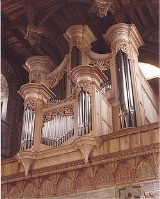
Harrison & Harrison
Encyclopedia

Pipe organ
The pipe organ is a musical instrument that produces sound by driving pressurized air through pipes selected via a keyboard. Because each organ pipe produces a single pitch, the pipes are provided in sets called ranks, each of which has a common timbre and volume throughout the keyboard compass...
s, based in Durham
Durham
Durham is a city in north east England. It is within the County Durham local government district, and is the county town of the larger ceremonial county...
and established in 1861. They are well known for their work on instruments such as King's College Cambridge, Westminster Abbey
Westminster Abbey
The Collegiate Church of St Peter at Westminster, popularly known as Westminster Abbey, is a large, mainly Gothic church, in the City of Westminster, London, United Kingdom, located just to the west of the Palace of Westminster. It is the traditional place of coronation and burial site for English,...
and the Royal Festival Hall
Royal Festival Hall
The Royal Festival Hall is a 2,900-seat concert, dance and talks venue within Southbank Centre in London. It is situated on the South Bank of the River Thames, not far from Hungerford Bridge. It is a Grade I listed building - the first post-war building to become so protected...
.
History of the firm
Thomas Harrison established an organ building company in 1861 in RochdaleRochdale
Rochdale is a large market town in Greater Manchester, England. It lies amongst the foothills of the Pennines on the River Roch, north-northwest of Oldham, and north-northeast of the city of Manchester. Rochdale is surrounded by several smaller settlements which together form the Metropolitan...
, then moved to Durham
Durham
Durham is a city in north east England. It is within the County Durham local government district, and is the county town of the larger ceremonial county...
in 1872. The company was moderately successful but did not achieve real success until 1896 when Thomas's sons Arthur and Harry took over. Harry designed the organs and Arthur proved to be a particularly gifted voicer, resulting in commissions for rebuilds of several great organs including Durham Cathedral
Durham Cathedral
The Cathedral Church of Christ, Blessed Mary the Virgin and St Cuthbert of Durham is a cathedral in the city of Durham, England, the seat of the Anglican Bishop of Durham. The Bishopric dates from 995, with the present cathedral being founded in AD 1093...
, the Royal Albert Hall
Royal Albert Hall
The Royal Albert Hall is a concert hall situated on the northern edge of the South Kensington area, in the City of Westminster, London, England, best known for holding the annual summer Proms concerts since 1941....
and new commissions including Westminster Abbey
Westminster Abbey
The Collegiate Church of St Peter at Westminster, popularly known as Westminster Abbey, is a large, mainly Gothic church, in the City of Westminster, London, United Kingdom, located just to the west of the Palace of Westminster. It is the traditional place of coronation and burial site for English,...
.
Arthur Harrison died in 1936 and Harry retired in 1946. The company passed to Harry's son Cuthbert. Since 1975, the firm has been led by Mark Venning.
In the postwar period Harrisons contributed significantly to the renaissance of classical organ building; their instruments for the Royal Festival Hall
Royal Festival Hall
The Royal Festival Hall is a 2,900-seat concert, dance and talks venue within Southbank Centre in London. It is situated on the South Bank of the River Thames, not far from Hungerford Bridge. It is a Grade I listed building - the first post-war building to become so protected...
(designed in close collaboration with Ralph Downes
Ralph Downes
Ralph William Downes CBE was an English organist, organ designer, teacher and music director, and was formerly Professor of Organ of the Royal College of Music....
) and St Albans Abbey (for Peter Hurford
Peter Hurford
Peter Hurford OBE is a British organist, born St Cecilia's day 1930 in Minehead, Somerset.Educated at Blundell's School, he later studied both music and law at Jesus College, Cambridge, graduating with dual degrees, subsequently obtaining an enviable reputation for both musical scholarship and...
) are of particular importance.
A history of the firm entitled 'The Harrison Story' was published in 1974 by Laurence Elvin
Some Harrison & Harrison Organs
- Royal Festival Hall
- Westminster Abbey
- King's College, Cambridge
- St David's Cathedral, Wales
- Coventry Cathedral
- Durham Cathedral
- Newcastle City Hall
- St Mary Redcliffe, Bristol
- Ely Cathedral
- Holy Trinity Cathedral, Auckland NZ
- Church of The Holy Spirit, Lake Forest, Illinois
- Anglican Cathedral of Sts. Mary and Nicholas, Seoul, Korea
External links
----

